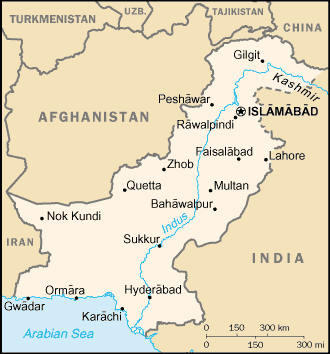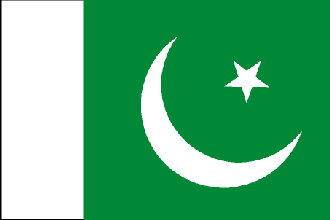
|
Pakistan
Background:
The separation in 1947 of British India into the Muslim state of Pakistan (with
two sections West and East) and largely Hindu India was never satisfactorily
resolved. A third war between these countries in 1971 resulted in East Pakistan
seceding and becoming the separate nation of Bangladesh. A dispute over the
state of Kashmir is ongoing. In response to Indian nuclear weapons testing,
Pakistan conducted its own tests in 1998.
Location:
Southern Asia, bordering the Arabian Sea, between India on the east and Iran
and Afghanistan on the west and China in the north.
Area: Total: 803,940 sq km, land: 778,720 sq km, water: 25,220 sq km.
Area - comparative: Slightly less than twice the size of California.
Land boundaries: Total: 6,774 km, border countries: Afghanistan 2,430 km,
China 523 km, India 2,912 km, Iran 909 km.
Coastline: 1,046 km.
Climate and Terrain:
Climate: Mostly hot, dry desert; temperate in northwest; arctic in north.
Terrain: Flat Indus plain in east; mountains in north and northwest;
Balochistan plateau in west.
Natural resources: Land, extensive natural gas reserves, limited petroleum,
poor quality coal, iron ore, copper, salt, limestone.
People:
Population: 147,663,429.
Ethnic groups: Punjabi, Sindhi, Pashtun (Pathan), Baloch, Muhajir (immigrants
from India at the time of partition and their descendants).
Religions: Muslim 97% (Sunni 77%, Shi'a 20%), Christian, Hindu, and other 3%.
Languages: Punjabi 48%, Sindhi 12%, Siraiki (a Punjabi variant) 10%, Pashtu 8%,
Urdu (official) 8%, Balochi 3%, Hindko 2%, Brahui 1%, English (official and
lingua franca of Pakistani elite and most government ministries), Burushaski,
and other 8%.
Government:
Government type: Federal republic.
Capital: Islamabad.
Independence: 14 August 1947 (from UK).
Economy overview:
Pakistan, an impoverished and underdeveloped country, suffers from internal
political disputes, lack of foreign investment, and a costly confrontation with
neighboring India. Pakistan's economic prospects, marred by poor human
development indicators, low levels of foreign investment, and reliance on
international creditors for hard currency inflows, were nonetheless on an
upswing through most of 2001. The Musharraf government made significant inroads
in macroeconomic reform - it completed an IMF short-term loan program for the
first time and improved its standing with international creditors by increasing
revenue collection and restraining the fiscal deficit in the 2001/02 budget.
GDP - composition by sector: Agriculture: 26%, industry: 24%, services: 50%.
Statistics:
Telephones - main lines in use: 2.861 million.
Telephones - mobile cellular: 158,000.
Radio broadcast stations: AM 27, FM 1, shortwave 21.
Radios: 13.5 million.
Television broadcast stations: 22 (plus seven low-power repeaters).
Televisions: 3.1 million.
Internet users: 1.2 million.
Railways: Total: 8,163 km.
Highways: Total: 247,811 km, paved: 141,252 km, unpaved: 106,559 km.
Airports: 120, with paved runways: 85, with unpaved runways: 35.
Heliports: 9.
Return to Visiting Locations
|

